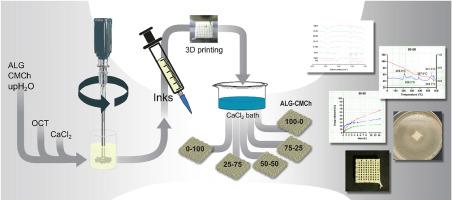3D-printed biopolymer matrices for the vehiculization and controlled release of octenidine in wound antibiotic therapy
IF 4.9
3区 医学
Q1 PHARMACOLOGY & PHARMACY
Journal of Drug Delivery Science and Technology
Pub Date : 2025-09-23
DOI:10.1016/j.jddst.2025.107558
引用次数: 0
Abstract
Chronic and acute wounds are important health system problems due to re-hospitalization rates and treatment engagement. Antibiotic-controlled release systems can be a relevant solution for generating long-term therapies without patient intervention. The present work investigated pH-sensitive biopolymeric systems obtained by extrusion-based 3D printing. Alginate and carboxymethyl chitosan were used as matrix polymers for ink production, while octenidine was the vehiculized antibiotic. Different polymer proportions were explored to evaluate the release mechanism in response to different pH environments. Physicochemical characterization was performed using infrared spectrometry (FTIR) and thermogravimetric analysis (TGA). Detailed photography was used to determine 3D-printing fidelity. SEM images were used for the morphological characterization. Swelling and octenidine release profiles were evaluated in different non-chelating buffers. After the print's crosslinking bath, the obtained encapsulation efficiency was 100 %. The printing fidelity was in the order of 0.9–1.8. Swelling studies showed that some formulations lost weight, whereas others increased by 400 %. After 7 days, the drug released was 20–85 %, depending on the polymer composition and buffer/pH environment. All the prints presented antimicrobial capacity against Staphylococcus aureus. The present work demonstrates the potential of biopolymeric 3D-printed systems as advanced wound dressings, combining pH-responsive antibiotic release and antimicrobial activity with the adaptive design capabilities of 3D printing, offering a versatile platform for personalized wound-healing therapies.

3d打印生物聚合物基质在伤口抗生素治疗中辛替尼啶的载体化和控释
由于再住院率和治疗参与,慢性和急性伤口是重要的卫生系统问题。抗生素控制释放系统可能是一种相关的解决方案,可以在没有患者干预的情况下产生长期治疗。目前的工作研究了通过挤压3D打印获得的ph敏感生物聚合物系统。以海藻酸盐和羧甲基壳聚糖为基质聚合物,辛替尼定为载体抗生素。探讨了不同聚合物配比对不同pH环境的释放机理。采用红外光谱(FTIR)和热重分析(TGA)进行了理化表征。使用详细摄影来确定3d打印的保真度。扫描电镜图像用于形态学表征。在不同的非螯合缓冲液中评估肿胀和辛替尼啶释放曲线。经交联浴后,得到的包封率为100%。打印保真度在0.9 ~ 1.8之间。肿胀研究表明,一些配方减轻了体重,而其他配方则增加了400%。7天后,药物释放率为20 - 85%,取决于聚合物组成和缓冲液/pH环境。所有的指纹都显示出对金黄色葡萄球菌的抗菌能力。目前的工作证明了生物聚合物3D打印系统作为先进伤口敷料的潜力,将ph响应性抗生素释放和抗菌活性与3D打印的自适应设计能力相结合,为个性化伤口愈合治疗提供了一个多功能平台。
本文章由计算机程序翻译,如有差异,请以英文原文为准。
求助全文
约1分钟内获得全文
求助全文
来源期刊
CiteScore
8.00
自引率
8.00%
发文量
879
审稿时长
94 days
期刊介绍:
The Journal of Drug Delivery Science and Technology is an international journal devoted to drug delivery and pharmaceutical technology. The journal covers all innovative aspects of all pharmaceutical dosage forms and the most advanced research on controlled release, bioavailability and drug absorption, nanomedicines, gene delivery, tissue engineering, etc. Hot topics, related to manufacturing processes and quality control, are also welcomed.

 求助内容:
求助内容: 应助结果提醒方式:
应助结果提醒方式:


